
The Photographer and the Jade Mine: Documenting Extractive Governance Challenges in Myanmar's Kachin State
The road from Myitkyina to Hpakant is one of the worst I have ever traveled. After nine hours on this bumpy mountain path dotted with military checkpoints, I enter the heart of Myanmar’s jade country. This road has changed the life of many people, for better or for worse.
The Hpakant township in Kachin state is known as “the Land of Jade” for its high-quality stone, long prized by the Chinese for its beauty and symbolism. “Gold is valuable, but jade is priceless,” according to an old Chinese saying. Many years ago it was the native Kachins’ work to dive into the water, climb across the mountains, and look for a good piece of raw jade using an iron pick. Today the precious land attracts hundreds of thousands of men from across the country, who come with one dream—to find the shortcut to wealth.
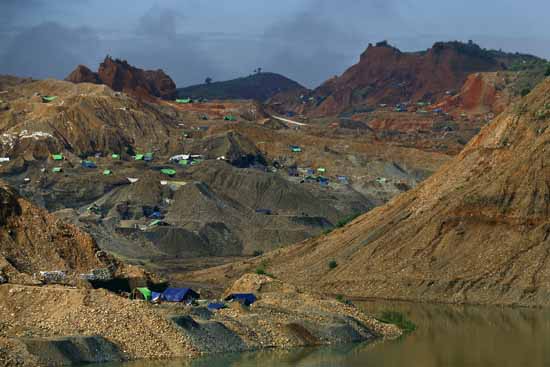
Looking through my viewfinder from a distant place … I see what looks like a nice picture … until I go closer and realize how dangerous the work is," Minzayar writes of the mines in Kachin State. (Photo by Minzayar for NRGI)
The first thing I saw, even before entering the village of Lone Khin, was four young boys digging the stones out from a hill, each with an iron rod in one hand and an umbrella in the other to fend off the rain. As soon as I entered the town, I saw the large compound of Myanmar Gems Enterprise (part of the Ministry of Mines). The motto written at the gate is “Open up the ground, let the country abound.”
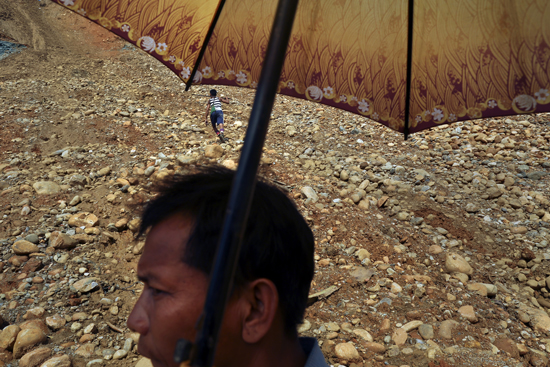
For some young illegal miners, crude tools consist of an iron pick “and an umbrella… to fend off the rain.” (Photo by Minzayar for NRGI)
I stayed in Lone Khin because of its well-known mining site, Hmaw Si Zar, which produces small but high-quality stones. The town is not very big if you exclude the mining sites, which can be sometimes larger than multiple football stadiums. Despite its size, the town is very busy and crowded because of the jade mining industry.
The black market bustles day and night as traders inspect raw jade, long prized for its beauty and symbolism. (Photo by Minzayar for NRGI)
In nearby Hpakant, there are hundreds of officially licensed companies—some small, some huge—eating up the mountains with backhoes, earthmovers and trucks. They began working around the clock here after the 1994 ceasefire between the Kachin Independence Army (KIA) and the Burmese military. The ceasefire brought Hpakant back under the control of the government, which shares the profit with the companies. In Lone Khin, a government mining office is supposed to evaluate the price of the stones, calculate tax and approve transportation.
Jade in fully loaded trucks cannot ship to buyers without transportation permits from the government. Illegal jade, however, is sold through the black market and smuggled to China. (Photo by Minzayar for NRGI)
At the bottom, informal end of this heap are the illegal freelance miners who wander around the piles of rubble dumped by companies and look for stones. Middle-men buy stones from the freelancers, traders buy and sell in the so-called “jade tea-shops” of the black market, and Chinese buyers smuggle jade across the border to China, with the service of carriers.
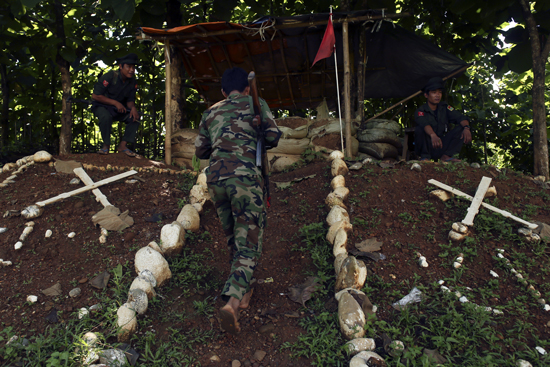
In Kachin State, on Myanmar’s northern border with China, legal mining operations ceased three years ago when fighting erupted between the national military and the Kachin Independence Army. The KIA asserts control of the territory using checkpoints like this one—and funds its operations in part through jade trading. (Photo by Minzayar for NRGI)
When fighting between the KIA and the Burmese military resumed in June 2011, the companies ceased their operations (only to resume them again recently). After that, the freelancers worked not only on the rubble piles but also across the company sites.
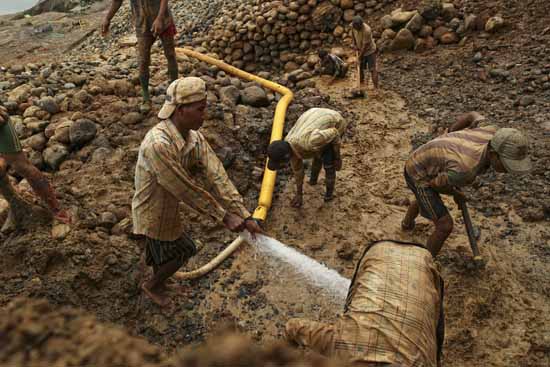
Despite the danger, hundreds of thousands of men come from across the country, wandering piles of rubble dumped by companies and looking for valuable stones. (Photo by Minzayar for NRGI)
Looking across a valley toward the mine sites, I see what looks like a nice picture, with so many people working industriously like ants on a mound. But then through my viewfinder I look through a long telephoto lens, and realize how dangerous the work is. I hear that landslides can often swallow many men at a time, especially during the monsoon season. But the miners don’t seem to care about these dangers too much. It seems their priority remains finding one stone that might become their ticket to wealth.
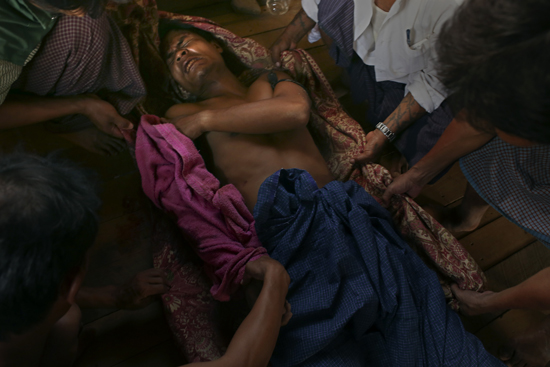
An injured miner is sent to a clinic. Illegal mining grows even more perilous when monsoon rains destabilize banks and slag heaps. Landslides may swallow 20 men at once. (Photo by Minzayar for NRGI)
Beyond the weather and the precarious terrain, another routine risk for the illegal miners is arrest. One morning I run into a scene where the miners are swimming in the lake between two mountains—but this is no recreational dip. They are in fact trying to escape arrest by the police and soldiers, who had chased them from one side and who now wait on the other side. Behind the armed forces, a crowd of angry and worried miners’ families gather. The miners won’t come to the shore. Instead, they wait in the lake with the help of buckets that their families throw to them to help them float. This way they they avoid arrest—for today, anyway. After a while, the police and soldiers leave.
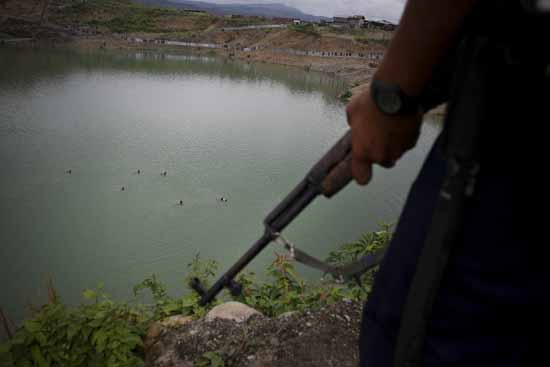
During a raid, illegal miners swim out into a mountain lake to avoid arrest by the police and military who wait on shore. (Photo by Minzayar for NRGI)
It happens once every couple of weeks, some of the illegal miners tell me. The unlucky ones are arrested and then released after paying a small amount of money. “They arrest us, local people who are working in our own land, when they let the Chinese steal away the precious wealth from our country,” one miner complains.
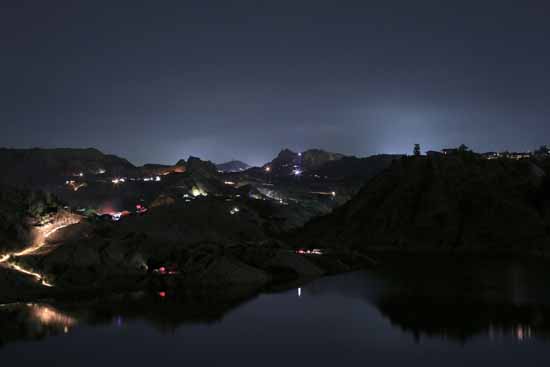
The sun may set, but the mine still teems with workers throughout the night.(Photo by Minzayar for NRGI)
The jade mine itself never rests. Some miners work all day, some all night, some for their families, some to buy the heroin, addiction to which is rampant here. Drug use is intrinsic to jade mining, with “shooting galleries” operating almost openly in Hpakant and miners often exchanging lumps of jade for hits of heroin. One evening, I see dozens of miners lining up for the drug. One of them told me, “Without this I am very tired, but after the shot, I feel happy to work again and I can chase my dreams again.”
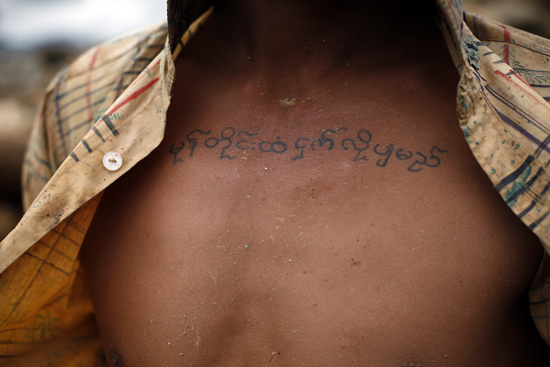
The tattoo sprawled across this miner’s chest reads, "I will fly like a bird into the storm." (Photo by Minzayar for NRGI)
This illicit fuel for their perilous jobs is not so expensive. You can buy a hit of heroin for 2,000 kyat, about $2—perhaps not coincidentally the black market price of the most tinny, low-quality piece of jade. But then again some raw pieces of jade sell for hundreds of thousands of dollars.
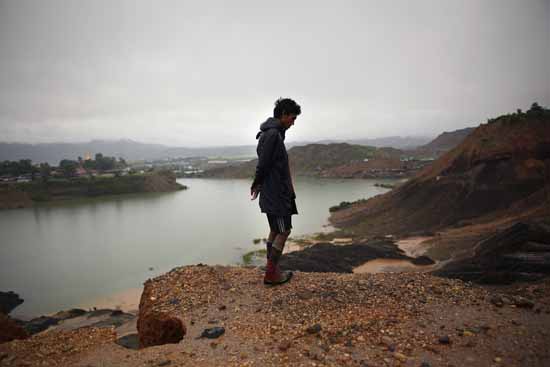
“The native Kachin man worries that his ‘Land of Jade’ could be gone within a decade," Minzayar writes, and with it, the opportunity to prosper as a people. (Photo by Minzayar for NRGI)
In September 2014, the government allowed the companies to resume operations in Hpakant. Some freelance miners prefer the freedom to work in the company sites; others prefer to search the company waste. Either way, jade mining will not stop in Hpakant as long as there is jade coming out of the Kachin mountains. But with the scale and the speed of modern extractions, the native Kachin man worries that his “Land of Jade” could be gone within a decade—and with it, the opportunity to use this finite resource to contribute to the development of his people, who presently see little benefit at all.
Minzayar (full name Min Zayar Oo) is an independent photojournalist based in Yangon, Myanmar. He has also made a film about the issues covered in this post. Learn more about jade mining and natural resource governance issues here.
